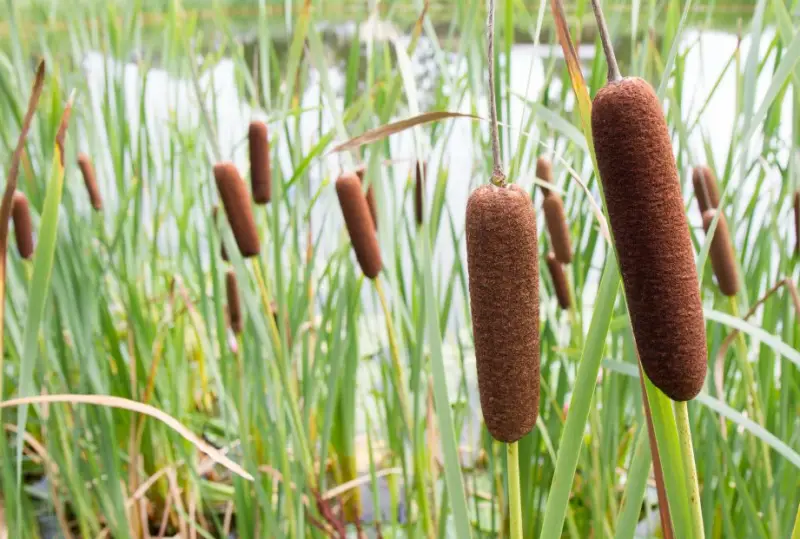The cattail plant (Typha latifolia), also commonly known as bulrush or broadleaf cattail, is a hardy perennial aquatic plant found in wetlands, marshes, and other boggy areas around the world. This iconic plant, with its long, slender leaves and distinctive brown sausage-shaped flower spikes, can grow up to 10 feet tall and is a staple in many aquatic landscapes. Cattails are known for their rapid growth and ability to thrive in waterlogged environments, providing essential cover and food for wildlife.
In this comprehensive guide, we’ll cover everything you need to know about cattail plant care, including how to grow, propagate, and maintain them in your water garden or natural landscape.
Overview of Cattail Plant

Before diving into the care and maintenance of cattails, let’s get familiar with the plant’s basic characteristics:
- Common Name: Common cattail, broadleaf cattail, bulrush.
- Botanical Name: Typha latifolia.
- Family: Typhaceae.
- Plant Type: Perennial, herbaceous.
- Mature Size: 5-10 ft. tall, 18-24 in. wide.
- Sun Exposure: Full sun to partial shade.
- Soil Type: Moist, loamy soil.
- Soil pH: Acidic to alkaline (variety of conditions).
- Bloom Time: Summer.
- Flower Color: Brown.
- Hardiness Zones: USDA Zones 3-10.
- Native Areas: Europe, North America, Asia.
Benefits of Growing Cattail Plants
Growing cattail plants can offer several environmental and aesthetic benefits:
- Wildlife Habitat: Cattails create a dense habitat for wildlife such as birds, amphibians, and insects. The plant’s tall growth provides cover and shelter, while its dense root system helps improve water quality by filtering pollutants and stabilizing the soil.
- Erosion Control: Due to their extensive rhizome system, cattails are great for controlling erosion along shorelines and marshy areas. Their roots bind the soil and prevent it from being washed away by water currents.
- Natural Filtration: Cattails are excellent for bio-filtration in ponds and wetlands, as their roots absorb excess nutrients like nitrogen and phosphorus, which can help prevent algal blooms and improve water clarity.
- Aesthetic Appeal: The tall, upright stems of cattails add a vertical element to water gardens and wetlands, while their unique brown flower spikes add visual interest throughout the year.
- Edible Uses: Various parts of the cattail plant, including its young shoots, rhizomes, and pollen, are edible and have been used by indigenous cultures for centuries as a food source.
How to Grow Cattail Plants
Cattail plants are relatively easy to grow and can become a striking feature in water gardens, ponds, or other moist areas. Here’s a step-by-step guide to successfully growing cattails.
Selecting the Right Location
Cattails thrive in sunny locations with plenty of water. Choose a site that receives full sun for at least six hours per day, although they can also tolerate partial shade. Cattails do best in areas with standing water or consistently wet soil, such as the edge of ponds, streams, or bogs.
Soil Requirements
Cattails prefer rich, loamy soil that retains moisture well. They can tolerate a range of soil pH levels, from acidic to alkaline, but the key is to ensure the soil remains consistently moist or submerged. For garden ponds or water features, you can plant cattails in the shallow margins or directly in submerged containers.
Planting Cattail Plants
Cattails can be planted using seeds, rhizomes, or transplants. Here’s how to plant them:
- From Rhizomes: Dig a hole in the moist soil, place the rhizome horizontally, and cover it with a few inches of soil. Ensure the rhizome is planted in an area that remains consistently wet.
- From Seed: Cattail seeds require a lot of moisture to germinate. Sow seeds on the surface of waterlogged soil, and keep them constantly wet until they sprout. Seeds can be started indoors in a shallow tray of moist soil and transplanted outdoors once they are well-established.
- From Transplants: Purchase young cattail plants from a nursery or divide existing cattails from another area. Plant them at the edge of ponds or water bodies, with their roots submerged in shallow water (up to 12 inches deep).
Watering Requirements
Since cattails are aquatic plants, they need an abundance of water to thrive. Keep the soil or planting area constantly wet, and for best results, plant cattails in shallow standing water. If grown in garden beds or rain gardens, water frequently to maintain moist conditions.
Fertilizing
Cattails generally don’t require fertilization, as they are highly adaptable and thrive in nutrient-rich wetland environments. However, if you notice slow growth or yellowing leaves, you can apply a balanced water garden fertilizer in the spring to give them a nutrient boost.
Maintenance and Care for Cattail Plants
Once established, cattails require minimal maintenance. However, there are some essential tasks you’ll need to perform to keep them healthy and prevent overgrowth.
Pruning
Cattails grow quickly and can become invasive if left unchecked. In the fall, when the plant’s growth slows down, use sharp pruning shears to cut the stems back to about eight inches above the surface of the water. If the plants are not in standing water, you can prune them all the way down to the ground. This encourages fresh growth in the spring.
Controlling Overgrowth
Cattails spread via rhizomes, and they can quickly take over wetland areas if not properly managed. To prevent invasive growth, consider planting cattails in bottomless containers or submerged pots. These containers will limit their spread and make it easier to control their growth.
If cattails become too dense, you can divide the plants by digging up the rhizomes and replanting them in new locations.
Winter Care
Established cattails are hardy and can withstand cold temperatures and frost. In USDA zones 3-10, cattails go dormant during the winter months but will regrow in the spring. For added protection in colder climates, you can mulch around the base of the plants to insulate the roots.
Propagating Cattail Plants
Cattails can be propagated by dividing their rhizomes or by sowing seeds. Here’s how to propagate cattails:
- Rhizome Division: In the spring, dig up the rhizomes from an established plant, ensuring each division has a healthy root system. Replant the divided sections in a suitable location with plenty of water.
- Seed Propagation: Start by soaking cattail seeds for 24 hours to soften them. Press the seeds onto the surface of moist soil and cover them lightly with compost. Keep the soil consistently wet, and within two weeks, the seeds should germinate. Transplant the seedlings outdoors once they are strong enough to handle outdoor conditions.
Common Pests and Problems
Cattails are generally pest-free, but their biggest threats come from larger animals such as muskrats and crayfish, which may graze on the plants. Fortunately, cattails grow so prolifically that animal grazing typically doesn’t cause significant damage.
Controlling Cattail Invasiveness
While cattails are a beneficial plant in wetland environments, they can become invasive if not controlled. Non-native cattails, in particular, can disrupt ecosystems by forming dense colonies that outcompete other plants and clog waterways. To prevent cattails from becoming a problem:
- Regularly prune and thin out the plants.
- Cut off the flower spikes in the fall to prevent seed dispersal.
- Use physical barriers, such as submerged containers, to control rhizome spread.
Conclusion
The cattail plant is a versatile and valuable addition to any water garden, wetland, or pond. Its striking appearance, ease of care, and environmental benefits make it a popular choice for gardeners and landscapers alike. By following the care tips outlined in this guide, you can ensure that your cattail plants thrive, creating a lush, natural habitat for wildlife while adding a unique visual element to your outdoor space. Just remember to manage their growth to prevent overpopulation, and enjoy the beauty and functionality these remarkable plants provide!






